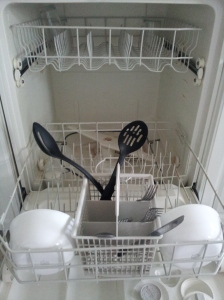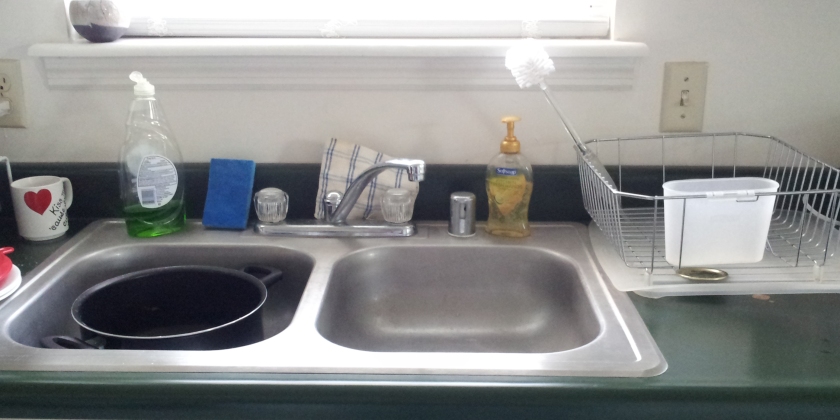Washing dishes is easy, right? Just shove ’em in the dishwasher or leave them in the sink for the Dish Fairy, amiright? Alas, my little fledglings, there is no magical Dish Fairy once you’ve left the nest. Hint: there never was one. (Crazy, I know.)
There’s an old joke about a young bachelor who, upon learning his mother was coming to visit, filled the bathtub with his dirty dishes so she wouldn’t see them piled on his kitchen counter. Dishes are one of those things best done early and often, as the task may seem overwhelming once they’ve piled up a bit. Always scrape any excess food particles into a trash can or in-sink garbage disposal. Next, figure out whether the dish in question can be put in the dishwasher (if you have one), or if it has to be hand-washed. For me, it seems obvious which dishes have to be hand-washed, but my fledgling roommates needed some help, so I created a decision tree to help them figure it out on their own. While it doesn’t cover everything (yes, my Corelle platter is technically larger than a dinner plate; no it doesn’t HAVE to be hand-washed), it’s a good start for making smart choices.
The Wash Box
If you have a dishwasher and you live in rental housing, chances are good the dishwasher sucks. For as long as I am at the mercy of a landlord’s “whatever’s cheapest” appliance selection policy, I prefer hand-washing my dishes if I want to be certain they are clean. However, since there are three of us in the apartment (plus occasional guests), it makes sense to use the dishwasher to save time. The machine is run at least once a week so that we are never completely out of clean dishes (though I do have plenty of dishes).
There are a few foods which don’t come off easily in an automatic dishwasher. If the dish or utensil touched peanut butter, eggs, oatmeal, or other sticky substances, even a decent dishwasher may struggle to get them clean; hand wash those items instead. Likewise, milk residue tends to stick to glassware, but it’ll come off cleanly if you give the glass a quick rinse prior to placing it on the rack.
Load the dishwasher from back to front, putting taller items like plates at the back of the rack, and shorter items in the front. Pay attention to where the water jets will come from (hint: the blade at the bottom of the machine) and try not to block the jet from reaching the top rack, or move items on the top rack to places where they are not blocked. Face plates and bowls toward the jet, and load utensils into their basket with “business end” exposed. However, if putting sharp knives in the dishwasher, put those point-down so you can remove them safely later. If you don’t have a utensil basket, save a plastic mesh produce bag and place your utensils in that in a single layer on the top rack. Glasses should always go on the top rack, but if pressed for space on the bottom rack, bowls can also be loaded at the top with their insides facing down.

Don’t overload the dishwasher! The more dishes you have crammed into the box, the less-effectively each piece will be washed. Modern all-in-one pellets have simplified the detergent-loading process, and many include a rinsing agent to help combat spots from hard water. Once the dishwasher has finished, dry off the clean dishes with a dish towel, and put them back in their cabinets so that the dishwasher is ready to begin accepting dirty dishes again. The dishwasher is not a cupboard, so don’t use it to store clean dishes; instead, put your dirty dishes into the machine as soon as you’ve used them. This way, your kitchen counters are more likely to stay dirty-dish-free, thereby reducing your risk for nasty odors, bacteria and fungus growth, and ants, gnats, and fruit flies.
Elbow Grease
There are two main methods for washing dishes, each of which relies on the number of basins (also called “bowls”) you have for your sink. Most American kitchens built or remodeled since the 1950s have two basins, but there’s been a recent trend back to deep single-bowl sinks in modern kitchens. A double-bowl sink does not mean “more places to pile dirty dishes”, however, as you should leave one bowl empty and clean for food prep and rinsing. For the best workflow, put your dish drain on the counter adjacent to the “rinse” side of the sink. If you have only a single bowl, you may want to consider buying a washtub to use for washing dirty dishes, leaving the rest of the sink free for rinsing and food prep.

Running Stream
If you have a shallow single-bowl sink, you should probably consider purchasing a washtub and use the next method. Otherwise, you can wash dishes one at a time using a soapy sponge or dishcloth. Self-dispensing scrubbers are a lifesaver! Rinse the dish, scrub, then rinse again. Repeat scrubbing and rinsing until the dish is clean, place it on a dish rack to dry, and move on to the next dish. This method can use quite a bit of water, especially if you leave the tap running between rinses.
Sudsy Reservoir
Run the tap until the water is as hot as you can tolerate, then close the drain on the “wash” side; make sure the strainer basket is in place but open on the “rinse” side. The amount of dishwashing liquid you’ll need is dependent upon how many dishes you’re going to be cleaning, but it is better to use “too much” soap than “not enough”. Greasier dishes will require more soap, and may even require direct application (more on that later). The water should be nice and sudsy, but keep the level low so that you have room to work without splashing. Then, choose your weapon: cloth, sponge, or scrubber. Each has its pros and cons, and I tend to use all three. Dishcloths are great for cleaning between the tines of forks and down into the bottom of drinkware; sponges are versatile and may eliminate the need for a separate scrubber for tough cleaning jobs. Brushes are of limited use with one exception: bottle brushes. Self-soaping tools are wasteful for this washing method.
My mom prefers rinsing each dish over the “rinse” side immediately after she washes it, then placing it in the dish drain. I prefer washing all the dishes at once and setting them in the “rinse” side, then rinsing all the clean dishes together before putting them in the drain. If I have a sink full of dishes, I tend to let the water out of the “wash” side, then pick up dishes one at a time from the “rinse” side and rinse them over the “wash” side, which has the double-benefit of rinsing suds out of the “wash” side, making clean up faster.
General Hand-washing Advice
- Never leave sharp knives in a sink, especially one full of soapy water. Instead, lay used knives on the back of the sink or wash them immediately.
- Particularly stubborn or dried-on foods may need to be soaked for several minutes prior to washing. If you know a dish contained food which will be tough to clean off once dried (starchy foods like pasta or potatoes, for example), fill it with water when you first put it in the sink, thereby saving soaking time when it’s finally time to wash. However, wooden utensils, cutting boards, and dishes should never be allowed to soak, as it will ruin the wood.
- The acid in tomatoes will stain and pit plastic when heat is applied. Never microwave tomato-based foods in a plastic dish, and try to avoid using anything plastic with tomato-based foods. Silicone can also be stained by tomatoes. Rinse the item thoroughly in COLD water, then wash.
- Some pots and pans will claim to be dishwasher safe, but to extend the life of the item, always wash by hand. This is especially important for Teflon-coated cookware and bakeware with rolled edges.
- Don’t forget to wash the outside, bottom, and handles of dishes! Even if these surfaces never came in direct contact with food, they may have picked up dirt and germs from your hands, the kitchen counter, or their place of storage.
- Greasy dishes require very hot water and plenty of soap. Hot water will help soften the grease, allowing you to wash it away more easily. For particularly greasy pans, I find it works best to apply dishwashing liquid directly to the pan, scrub with a scouring pad, and then rinse the dish with very hot water. You can then reapply the soapy scrubber if needed, and rinse again until the dish is clean.

When you’ve finished washing all the dishes, rinse and wipe out (both sides of) the sink with a dish cloth. If your strainer basket(s) captured any food particles, dump those in the trash can or flush down a garbage disposal. Allow dishes to air-dry on a dish drain or mat before putting them away, or dry by hand using a clean towel (don’t use the same towel you use for wiping your hands). If using a counter-top dish drain, make sure the drain mat underneath it is positioned so that water run-off will go into the sink. Rinse and wring out dish clothes, hanging them over the sink divider or faucet to dry; rinse sponges and scrubbers and prop them against the back-splash so they’ll dry without molding.
Properly-washed dishes and utensils will look better and last longer, saving you money over time. I find washing dishes by hand to be somewhat therapeutic, as it gives me an opportunity to let my mind wander freely while my hands are busy. In future articles, I’ll discuss methods for ridding your kitchen of odors, treating your pots and pans with care, and some important safety tips for the use of garbage disposal units.
What’s your best dish-washing advice?

My best dishwashing advice? At least once every 3 weeks works for me. Other than that, use dish soap free of synthetic crap (such as Seventh Generation).
I’m still in the “whatever’s least expensive but gets the job done without destroying my hands” market for dishwashing liquid. Perhaps one of these days I’ll be a little pickier, but for now, I’m loving my apple-scented Dawn, which I buy in a bulk-pack at Sam’s Club.
You would be so proud of me: I WASHED A HALF SINKFUL OF DISHES TODAY.
^_^